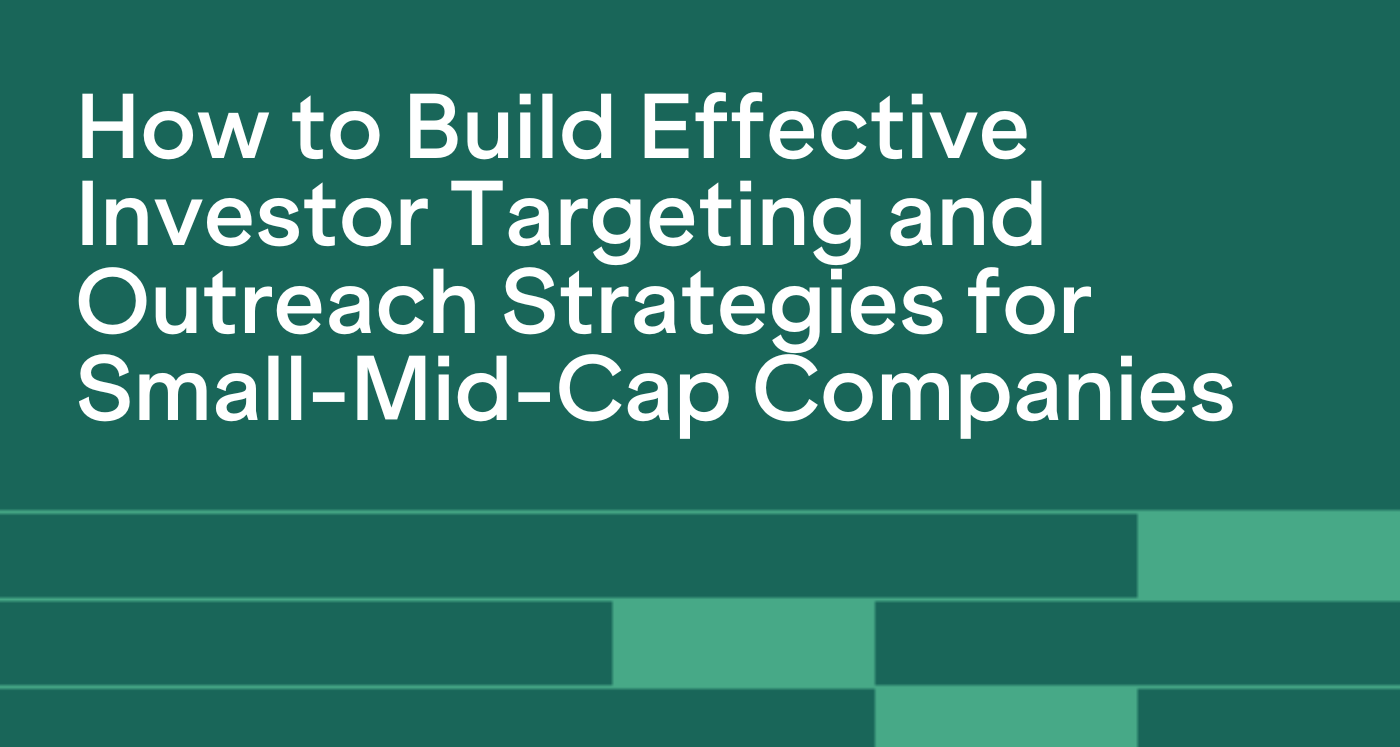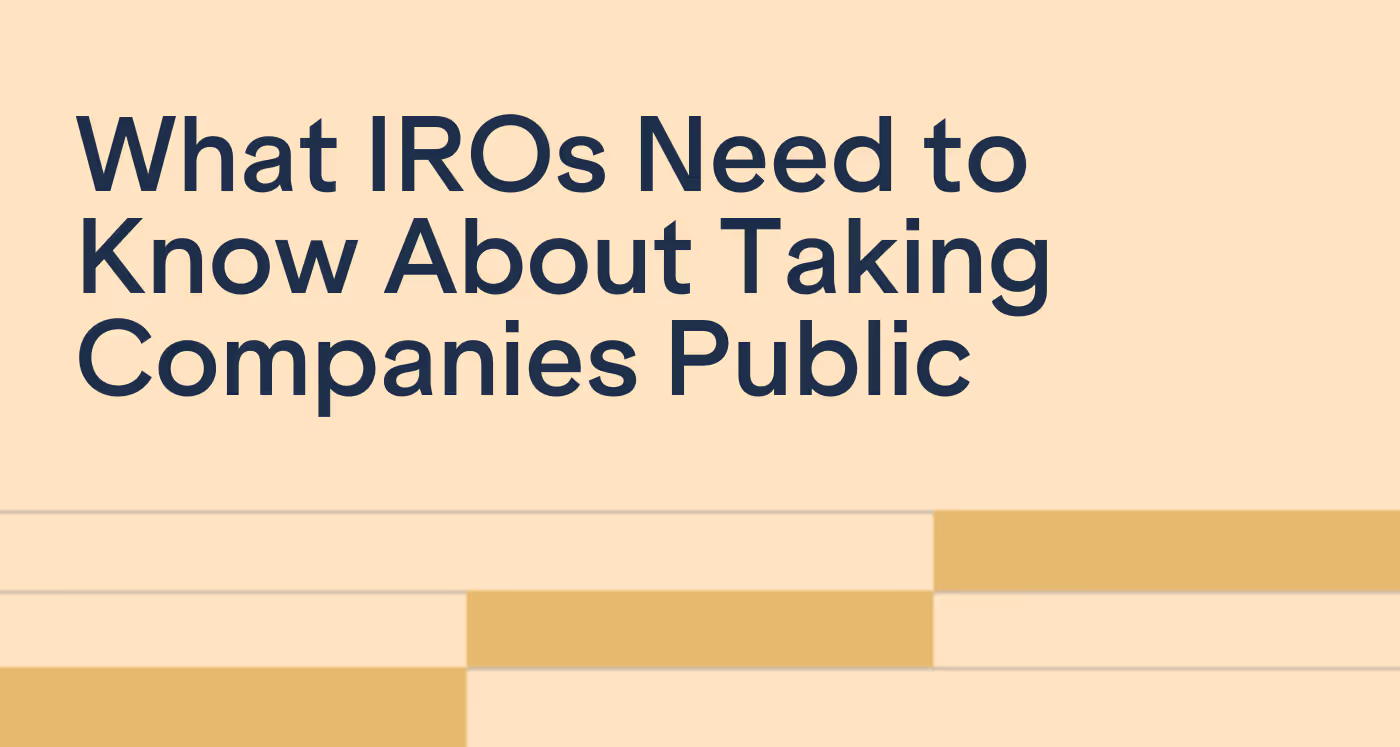
How to Build Effective Investor Targeting and Outreach Strategies for Small-Mid-Cap Companies
Learn how seasoned IR veterans are executing targeting strategies for small-mid-cap companies.

Last month Irwin CEO David Whyte brought together an expert panel for a candid discussion on the asset management industry’s evolution. With over 20+ years of capital markets experience, our panellists shared buy-side and issuer perspectives on how these changes impact a company's marketing strategy today.
If you missed the webinar, we’ve got you covered. Read on to meet the experts and discover the top tips our panellists suggest you prioritize in your 2022 investor relations activities.
Peter Mann is the Co-Chief Executive Officer of Grayhawk, an ultra-high net worth allocator managing more than $1.3 billion AUM.
Christopher Ritchie transitioned to his role as President of SilverCrest Metals (~$2B market cap) in January 2018 after serving as a key financial advisor and partner to the company through roles with National Bank Financial and Canaccord Genuity.
Michael Capombassis is the President of Bristol Gate Capital Partners, an employee-owned asset management boutique managing close to $3 billion in AUM/AUA across a US and Canadian equity strategy.
The industry’s evolution has been around the very notion of active to passive management, but Peter shares it’s more fundamental than that. Asset managers are seeking ideas where capital is flowing most, and there's been a long cycle that’s proven averages doing very well. It's hard for the majority of people to outperform — mathematically, it's not possible. With that basis, people start looking at what they're paying for what they're getting.
One of the biggest differentiators that the industry has seen in the last number of years, particularly with successful families and foundations, is how much money stays in public markets versus how much of it remains in private markets. The duality is what people are ultimately trying to source.
“Is there a balance between the alpha generated in parts of the market that aren't as regulated relative to the efficiency that the tailwind has brought for the market overall?”
For the last ten-plus years, active management in the public markets has been challenging because most active managers have difficulty beating the respective benchmark against them, and they tend to have higher fees.
Mike views the current active management industry on a spectrum. On one end, the biggest players — the Fidelitys and the Black Rocks — will continue to do well. They have the capital to leverage their cost base and invest in technology, talent, and new products.
In the middle, “closet indexers” who don't deliver competitive, risk-adjusted returns and charge higher fees will continue losing money to passive.
On the other end of the spectrum, there are world-class boutique investment managers. They compete in a sliver of the equity markets with a limited number of products, run concentrated portfolios, and have proven and durable investment processes that add value to that particular pocket of the equity or fixed-income markets.
If you look to the United States for what to expect in Canada next, you'll see fee compression. If you can't deliver competitive risk-adjusted returns after fees for your investors, your businesses will have a hard time growing.
With how competitive asset and wealth management is, and how much fees have come down, active managers who deliver something unique or something special will not only survive but thrive.
Market structure, fee pressure, and financial disintermediation are all causing fund mandates to change. Fee pressure for active managers competing against the passive market, which is now bigger than the active market, means companies have to put more money to work per idea. But, unfortunately, too many IROs forget to start by simply asking questions when they’re marketing.
“What’s your mandate?” “What do you do?” “What do you need?”
SilverCrest’s strategy is built by asking the question: how do you become relevant in an irrelevant sector? Chris explains the answer is size and scale — creating an investment vehicle that can resonate with the largest audience possible. SilverCrest’s structure, shareholder register, and how it thinks of its balance sheet and raises money, is all done with a broad reach approach and making money for investors as a way to gather interest.
When building a strategy, Peter suggests companies should bring an opportunity to investors that effectively closes every exit door. By doing so, the investor will understand the opportunity set and what you can deliver. However, the challenge within capital markets’ commoditized industry is that everyone tells a story that they think is unique. Unfortunately, for most, it ends up sounding the same as everybody else's.
Read the blog: How to Tell Your Company Story
How you narrate your story, define what those exit doors are, and the ability to put them in front of people allows for a different discussion and different outcomes. Leveraging Irwin is a big part of where software can be so beneficial for marketing — it can bring a more data-driven thought process to how you present the opportunity as it relates to an investor.
The ultimate takeaway for investor meetings is resoundingly clear: don’t enter a room with management if you are unprepared.
Unfortunately, in Peter’s experience, from a group perspective, almost 80 to 90 per cent are. Instead, management is force-fed information that is boilerplate, canned and adds no value to the decision-making process. Questions you can answer before arriving from information found online need to be better contemplated.
There is an onus on both the issuer and the investor to be prepared. IROs should brief management teams and ensure that they come with a depth of understanding with who they are sitting with — dig in on who's in the room, why they're there, and what it would mean for them to be on the company’s cap.
“There is a way for people to be up to speed, but it still really comes at the heart of one's willingness and desire to understand why they are there and what they're solving. And preparedness is probably the single most important thing that you can do as an investor.”
Another tip, once you’ve secured an investor meeting, is to listen more than you speak. Again, doing prep work ahead of time will allow you to ask the right questions. For example, Chris suggests asking, “what would our company do in your portfolio?” Asking this question enables you to refine your pitch and business model to make sure you can have an audience interested in you. Over time, issuers will get better at providing the investors with what they’re looking for — but if you don’t listen and you walk in and only preach, you’re wasting your time.
Lastly, be transparent with your business. Identify key risks and don’t hide them. Telling someone nothing is wrong with your business is a surefire way to make them not believe you.
Capital markets is a relationship-driven business. Unfortunately, Peter fears the industry systematically attempts to create efficient processes, but in actuality, creates boredom.
To secure better meeting outcomes, follow-ups should start with simple things that Peter thinks most firms don’t know how to do very well, which is the cadence of “thank you for your time” and “thank you for your effort.”
Follow-up is not an IR email that goes out; it is an email that comes from the CEO or the most senior person in the room. There are basic courtesies that go a long way to show understanding for the time committed. Making a personal connection from an investor meeting is no different than anything else in life.
Ultimately, you need to figure out what you’re trying to solve in a specific meeting. For Peter, follow-ups are always about hitting on the most relevant pieces that add value. That can come in the ability to narrate what the story is, how relevant it can be, and what it means from a longer-term perspective.
Using the power of technology, Chris explains one of SilverCrest’s relationship-building goals is to implement 15-minute marketing. For example, an email that digs deeper into a press release outlining trading details, liquidity, volume, relative value, and key risks could effectively provide enough detail to investors to eliminate the need for an hour-long meeting. Ultimately, this enables SilverCrest to become more efficient and still provides value.
The goal is to keep people informed with a back and forth that is mutually beneficial. Even if it has nothing to do with SilverCrest, Chris will share news that might be relevant to the other side of the table to create another chance for dialogue.
“How do you meet someone once and maintain a relationship if you’re not helping each other out? Expecting anyone on the buy-side to do extra work on something that you haven't done the work for — I just don't count on that as being a good strategy.”
To wrap the discussion, David shares an analogy — similar to dating, the deeper ingrained you are in the relationship, the harder it is to break up. Building relationships is the number one strategy that we encourage Irwin clients to work on.

The trending skill for IROs heading into 2022 is preparedness. If you’re meeting an investor, you should know their mandate and what they're looking for.
Understanding the mandate and the business model of the person on the other side of the table will give you the information you need to communicate on the same wavelength. Then, if you're wrong, or you're close, or you've done a good job at trying; hopefully, they're going to give you latitude or a chance to keep the ball rolling.
Showing the person across the table that you’ve done your due diligence for the meeting also shows them you have respect for their time. Your goal should always be to get to the next meeting, and the best way to do that is preparation.
Looking for more insights on how to refine your investor outreach strategy and secure better meeting outcomes? Watch the full replay of this webinar.
Learn how Irwin helps streamline your communication with shareholders.

Learn how seasoned IR veterans are executing targeting strategies for small-mid-cap companies.

Elizabeth Librizzi breaks down the secrets of buy-side corporate access to help investor relations professionals utilize buy-side firms.

What IROs Need to Know About Taking Companies Public: Insights from award winning investor relations thought leader Catherine Buan.